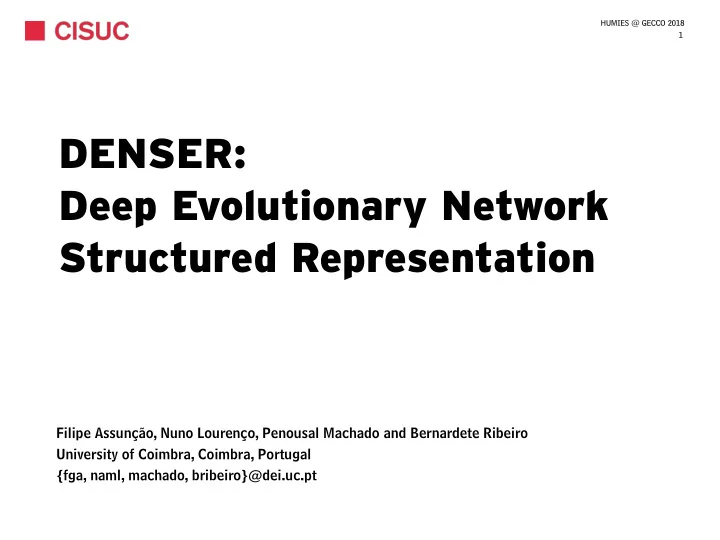

HUMIES @ GECCO 2018 1 DENSER: Deep Evolutionary Network Structured Representation Filipe Assunção, Nuno Lourenço, Penousal Machado and Bernardete Ribeiro University of Coimbra, Coimbra, Portugal {fga, naml, machado, bribeiro}@dei.uc.pt
DENSER: Deep Evolutionary Network Structured Representation HUMIES @ GECCO 2018 2 automated deep neural network design ‣ Select the Artificial Neural Network (ANN) type; ‣ Choose the sequence, type, and number of layers; ‣ Fine-tune the parameters of each layer; ‣ Decide the learning algorithm; ‣ Optimise the parameters of the learning algorithm.
DENSER: Deep Evolutionary Network Structured Representation HUMIES @ GECCO 2018 3 convolutional neural network feature extraction / classification representation learning
DENSER: Deep Evolutionary Network Structured Representation HUMIES @ GECCO 2018 4 denser < features > ::= < convolution > | < pooling > < convolution > ::= layer:conv [num-filters,int,1,32,256] [filter-shape,int,1,1,5] [stride,int,1,1,3] < padding > < activation > < bias > < batch-normalisation > < merge-input > < batch-normalisation > ::= batch-normalisation:True | batch-normalisation:False < merge-input > ::= merge-input:True | merge-input:False < pooling > ::= < pool-type > [kernel-size,int,1,1,5] [stride,int,1,1,3] < padding > < pool-type > ::= layer:pool-avg | layer:pool-max < padding > ::= padding:same | padding:valid < classification > ::= < fully-connected > < fully-connected > ::= layer:fc < activation > [num-units,int,1,128,2048 < bias > < activation > ::= act:linear | act:relu | act:sigmoid < bias > ::= bias:True | bias:False < softmax > ::= layer:fc act:softmax num-units:10 bias:True < learning > ::= learning:gradient-descent [lr,float,1,0.0001,0.1] ANN structure
DENSER: Deep Evolutionary Network Structured Representation HUMIES @ GECCO 2018 5 denser < features > ::= < convolution > | < pooling > < convolution > ::= layer:conv [num-filters,int,1,32,256] [filter-shape,int,1,1,5] [stride,int,1,1,3] < padding > < activation > < bias > < batch-normalisation > < merge-input > < batch-normalisation > ::= batch-normalisation:True | batch-normalisation:False < merge-input > ::= merge-input:True | merge-input:False < pooling > ::= < pool-type > [kernel-size,int,1,1,5] [stride,int,1,1,3] < padding > < pool-type > ::= layer:pool-avg | layer:pool-max < padding > ::= padding:same | padding:valid < classification > ::= < fully-connected > < fully-connected > ::= layer:fc < activation > [num-units,int,1,128,2048 < bias > < activation > ::= act:linear | act:relu | act:sigmoid < bias > ::= bias:True | bias:False < softmax > ::= layer:fc act:softmax num-units:10 bias:True < learning > ::= learning:gradient-descent [lr,float,1,0.0001,0.1] layers
DENSER: Deep Evolutionary Network Structured Representation HUMIES @ GECCO 2018 6 denser < features > ::= < convolution > | < pooling > < convolution > ::= layer:conv [num-filters,int,1,32,256] [filter-shape,int,1,1,5] [stride,int,1,1,3] < padding > < activation > < bias > < batch-normalisation > < merge-input > < batch-normalisation > ::= batch-normalisation:True | batch-normalisation:False < merge-input > ::= merge-input:True | merge-input:False < pooling > ::= < pool-type > [kernel-size,int,1,1,5] [stride,int,1,1,3] < padding > < pool-type > ::= layer:pool-avg | layer:pool-max < padding > ::= padding:same | padding:valid < classification > ::= < fully-connected > < fully-connected > ::= layer:fc < activation > [num-units,int,1,128,2048 < bias > < activation > ::= act:linear | act:relu | act:sigmoid < bias > ::= bias:True | bias:False < softmax > ::= layer:fc act:softmax num-units:10 bias:True < learning > ::= learning:gradient-descent [lr,float,1,0.0001,0.1] close-choice real-valued parameters parameters
DENSER: Deep Evolutionary Network Structured Representation HUMIES @ GECCO 2018 7 example of a candidate solution <features> <features> <features> <classification> <softmax> <learning> <features> <pooling> <pooling-type> <padding> [{DSGE: 1, [{DSGE: 0, [{DSGE: 1, [{DSGE: 0, {}] {kernel-size: 4, {}] {}] stride: 2}] Layer type: pooling ... ... Pooling func.: max Kernel size: 4 x 4 Stride: 2 x 2 Padding: same
DENSER: Deep Evolutionary Network Structured Representation HUMIES @ GECCO 2018 8 hinton
DENSER: Deep Evolutionary Network Structured Representation HUMIES @ GECCO 2018 9 hinton
DENSER: Deep Evolutionary Network Structured Representation HUMIES @ GECCO 2018 10 denser benchmarking
DENSER: Deep Evolutionary Network Structured Representation HUMIES @ GECCO 2018 11 denser vs. other automatic design methods (CIFAR-10) 94,3 94,13 94,02 93,725 93,63 Accuracy (%) 93,25 93,15 92,7 92,575 92 CoDeepNEAT CGP-CNN Fractional CGP-CNN DENSER (ConvSet) Max-Pooling (ResSet)
DENSER: Deep Evolutionary Network Structured Representation HUMIES @ GECCO 2018 12 denser vs. human-designed networks (CIFAR-10) 95 94,76 94,25 94,13 Accuracy (%) 94 93,5 93,39 92,75 92,26 92 VGG ResNet Human DENSER DenseNet Performance
DENSER: Deep Evolutionary Network Structured Representation HUMIES @ GECCO 2018 13 denser vs. human-designed networks (MNIST) 99,7 99,7 99,68 99,68 99,68 99,65 Accuracy (%) 99,6 99,55 99,5 ResNet Fractional VGG DENSER Max-Pooling
DENSER: Deep Evolutionary Network Structured Representation HUMIES @ GECCO 2018 14 denser vs. human-designed networks (FASHION-MNIST) 100 95 95,4 94,9 94,7 Accuracy (%) 93,5 90 85 83,5 80 Human VGG DENSER ResNet DenseNet Performance
DENSER: Deep Evolutionary Network Structured Representation HUMIES @ GECCO 2018 15 denser vs. human-designed networks (CIFAR-100) 78 77,51 75,75 75,58 Accuracy (%) 73,5 73,61 71,95 71,25 71,14 69 ResNet VGG Fractional DenseNet DENSER Max-Pooling
DENSER: Deep Evolutionary Network Structured Representation HUMIES @ GECCO 2018 16 robustness, generalisation, scalability 100 99,7 94,7 94,13 92,5 Accuracy (%) 85 77,5 77,51 70 CIFAR-10 MNIST Fashion-MNIST CIFAR-100 min. human-designed accuracy max. human-designed accuracy
DENSER: Deep Evolutionary Network Structured Representation HUMIES @ GECCO 2018 17 why the best entry? ‣ General purpose-framework for the automatisation of the search of Deep Artificial Neural Networks (DANNs); ‣ Results show that, without any prior-knowledge, DENSER can effectively discover (and even surpass) other automatic and human-designed DANNs; ‣ The CIFAR-100 result defines a new state-of-the-art; ‣ The evolved DANNs have proven to be robust, generalisable, and scalable; ‣ Low cost evolutionary ML approach.
DENSER: Deep Evolutionary Network Structured Representation HUMIES @ GECCO 2018 18 why the best entry? Input Output Conv:165:5:1:valid:norm:bias Argmax Merge Activation: Softmax Activation: ReLU FC:10:bias Conv:250:5:1:same:none:none Activation: Sigmoid Merge FC:495:bias Activation: Linear Activation: ReLU MaxPool:5:1:valid FC:1948:bias Conv:165:5:1:same:norm:bias MaxPool:5:2:same Merge Activation: ReLU MaxPool:2:1:same Conv:218:5:3:same:norm:bias MaxPool:3:2:same Activation: Linear MaxPool:4:3:same Conv:165:5:1:same:norm:bias MaxPool:3:2:same Merge MaxPool:3:2:same Activation: ReLU Activation: Linear Conv:157:4:2:same:none:bias Merge
HUMIES @ GECCO 2018 19 DENSER: Deep Evolutionary Network Structured Representation cdv.dei.uc.pt/denser Filipe Assunção, Nuno Lourenço, Penousal Machado and Bernardete Ribeiro University of Coimbra, Coimbra, Portugal {fga, naml, machado, bribeiro}@dei.uc.pt
Recommend
More recommend